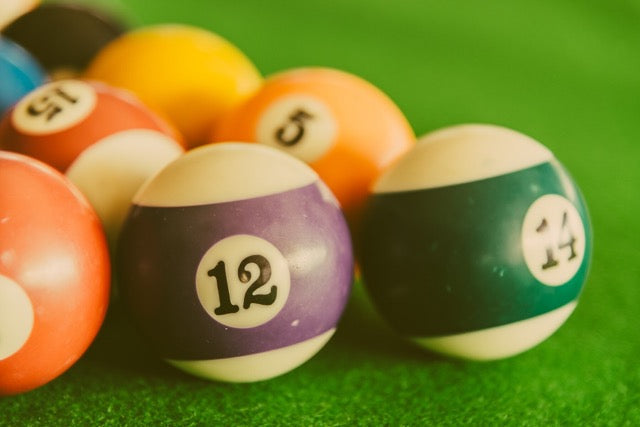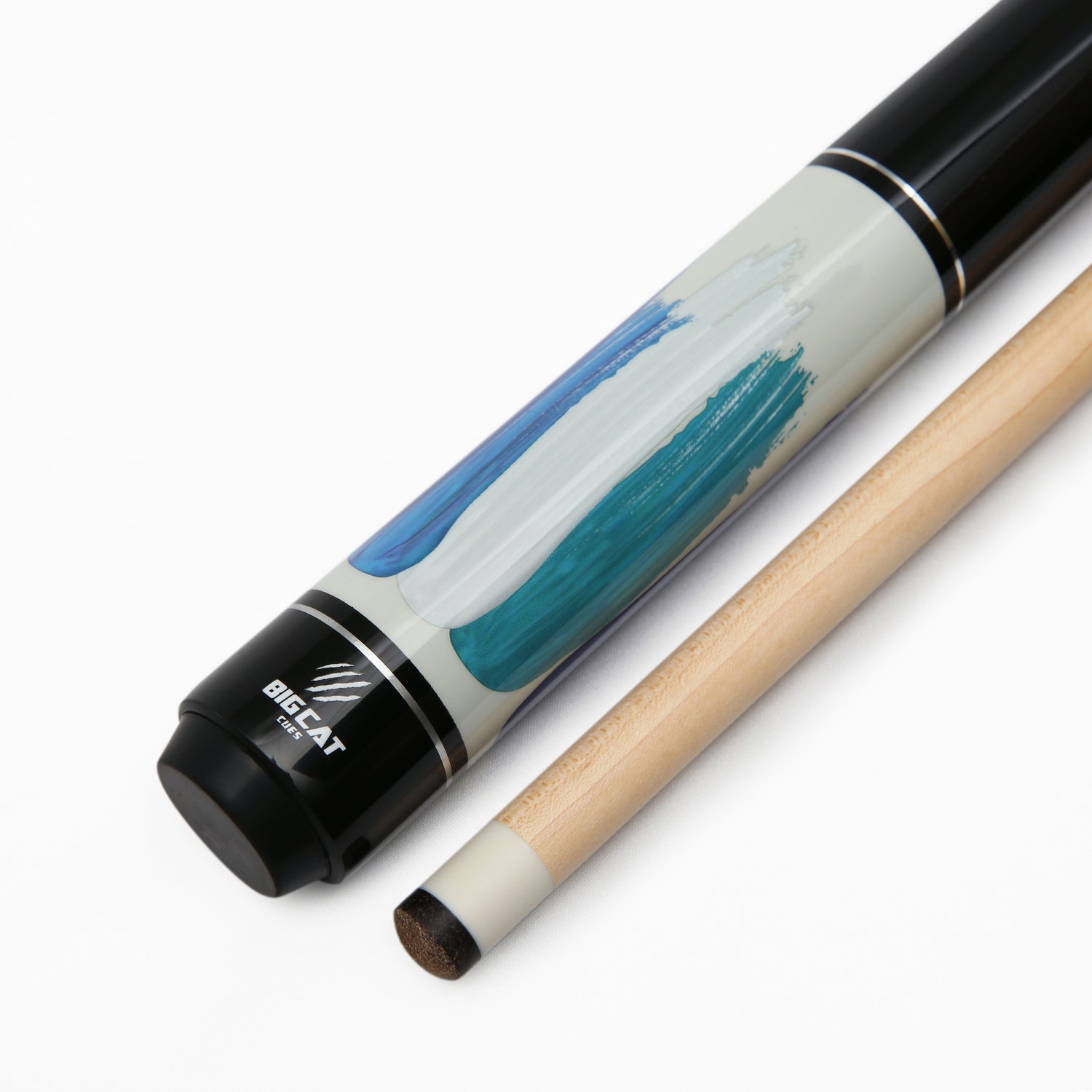
What Are Pool Balls Made Of? A Comprehensive Guide
Key Takeaways
-
Today, pool balls are primarily made of phenolic resin, known for its durability, heat resistance, and precision. Other materials like polyester and acrylic are used as budget-friendly options. Learn about what are pool balls made of below!
-
Early pool balls were made from wood, later replaced by ivory due to its strength and beauty. However, ivory’s ethical and environmental concerns led to the search for alternatives. Discover the full story of how pool balls evolved in this article!
-
Pool balls are crafted through a detailed process involving molding phenolic resin under high pressure and heat, cooling, polishing, and rigorous quality testing to ensure perfect size, weight, and roundness. Dive into the fascinating process of how pool balls are made.

What Are Pool Balls Made Of
Visit Big Cat Cues for quality, durable, budget-friendly pool cues for every player!
The Evolution of Pool Balls: A Historical Perspective
In the early days, pool balls were made of wood. Wood was affordable and easy to work with, but it lacked the durability and consistency needed for high-precision gameplay. As the game gained popularity, manufacturers began seeking better alternatives.
In the 17th century, ivory from elephant tusks became the material of choice. Ivory offered exceptional strength, beauty, and durability, making it ideal for pool balls. These “ivories” were highly prized, symbolizing wealth and luxury. However, their production was both costly and devastating to elephant populations, as one tusk could produce only four to five high-quality balls.

What pool balls look like in the 17th century. Source: The Antiques Almanac
By the 19th century, the unsustainable nature of ivory production and rising costs pushed manufacturers to seek alternatives. This led to the invention of celluloid, a precursor to modern plastics, by John Wesley Hyatt in 1869.
Although Hyatt’s celluloid balls mimicked ivory's appearance, they were far from perfect. They lacked durability and were notoriously unstable, with some even reportedly exploding upon impact. Despite these drawbacks, celluloid paved the way for the development of synthetic materials.
The true breakthrough came in the early 20th century with the invention of Bakelite, a type of phenolic resin. Bakelite was durable, heat-resistant, and cost-effective, making it an ideal material for pool balls.
See more: 10 Best Intermediate Pool Cues: 2025 Review Guide
Materials Used in Pool Balls Today and How Each Affect Your Play
If you’ve ever wondered, what are pool balls made of, or how are pool balls made, over time, pool balls have transitioned from traditional materials like wood and ivory to advanced plastics.
Today, the most common materials used include phenolic resin, polyester resin, and acrylic or other synthetics. Here’s a breakdown of these materials and their characteristics.
1. Phenolic Resin
Phenolic resin is the top choice for modern pool balls. This material is a type of plastic derived from phenol (originally sourced from tar but now extracted from petroleum).
In 1907, the invention of Bakelite, a form of phenolic resin, revolutionized pool ball manufacturing as a cheaper, durable, and heat-resistant alternative to ivory.
Pool balls made from phenolic resin are incredibly durable, lasting up to five times longer than those made from other materials. They can withstand the repeated impacts of gameplay without cracking or losing shape. This makes them the preferred choice for competitive and professional play.
Phenolic resin also ensures consistent weight, size, and performance, creating a fair playing experience.

Most pool balls nowadays are made from phenolic resin materials
2. Polyester Resin
Pool balls made of phenolic resin are the most common. However, polyester resin is another material used to make pool balls.
Polyester resin is a more affordable alternative to phenolic resin. Pool balls made from polyester are lighter and less durable, making them ideal for casual players or recreational settings.
Though, compared to phenolic resin, polyester resin is less resistant to heat and impact. Polyester balls may wear out faster with regular use, losing their smooth surface and roundness over time.
However, they are cost-effective, provide a decent experience for occasional players, and are sufficient for less competitive games.

Polyester resin pool balls. Source: Walmart
3. Acrylic or Other Synthetics
What are pool balls made out of?
Well, it isn’t just phenolic or polyester resin. They are also made out of acrylic and other synthetic materials, too.
Acrylic or other synthetic materials are often used to create entry-level pool balls. These are budget-friendly options designed for beginners or those new to the game. This material is lightweight and easy to produce.
While affordable, acrylic balls are not as durable as phenolic or polyester resin balls. They are prone to chipping, cracking, and losing their polished finish more quickly. For casual or short-term use, they can work well, but professional players may not prefer these acrylic balls for serious gameplay.

Acrylic pool balls. Source: Etsy
See more: How To Rack Pool Balls Like A Pro in 5 Steps?
Environmental and Ethical Considerations
So, what are billiard balls made of?
Mainly from ivory.
However, do you know ivory came from elephant tusks?
While ivory was known for its elegance and durability, using it came at a great ethical and environmental cost.
The high demand for ivory led to widespread poaching, threatening elephant populations and damaging ecosystems. As society became more aware of these issues, the use of ivory in manufacturing was phased out, and synthetic materials became the standard.
Let’s dive into the details of the environmental impacts of this material:
1. Environmental Impacts
Switching from ivory to synthetic materials has been a massive win for wildlife conservation. This ethical decision significantly reduced elephant poaching and its harmful effects on biodiversity.
While phenolic resin solves the ethical problem of ivory, it introduces environmental challenges. It is a petrochemical-based plastic, meaning it is made from oil, a finite resource. The production process also contributes to carbon emissions and pollution, raising concerns about sustainability.
Many manufacturers are now focusing on reducing waste and exploring environmentally friendly alternatives. Some companies aim to use recycled materials or innovate new solutions with a smaller environmental footprint.
Although pool balls are not yet fully sustainable, these efforts show progress toward minimizing the industry's ecological impact.
2. Ethical Considerations
The shift away from ivory is a clear ethical success. By using synthetic materials, the industry no longer contributes to the exploitation and endangerment of elephants, aligning with global conservation goals.
Not only that, leading manufacturers are increasingly mindful of their environmental and ethical obligations. They are investing in research to create sustainable materials while ensuring the performance standards demanded by players.
This approach reflects a growing awareness of the need to balance tradition, quality, and responsibility.
Unlike older materials like ivory or early plastics, phenolic resin provides an ethical, reliable, and durable solution. Occasionally, less expensive balls are made from polyester resin or acrylic, but phenolic resin is preferred for professional-grade balls due to its superior quality.

Switching to synthetic resin as a pool material is a great effort for an ethical success
See more: 12 Best Pool Cue Brands: Top-Rated In 2025
How Are Pool Balls Made?
What are pool balls made of? Mostly phenolic resin and some made from other synthetics.
But what about the process of making pool balls? Let’s check it out:
1. Material Preparation
The process begins with phenolic resin, which is mixed with dyes and additives to enhance its strength, durability, and vibrant colors. This liquid or semi-liquid resin is then prepared for shaping.
2. Molding the Ball
The phenolic resin is poured into round molds that determine the ball's size and shape.
During this step, the molds are subjected to extreme heat and pressure in a process called thermosetting. This hardens the resin into a solid, durable form while removing air bubbles and ensuring uniformity.
But, why is this process important?
Thermosetting gives the balls a consistent density and precise dimensions, which are critical for fair and predictable gameplay.
3. Cooling and Trimming
After the resin sets, the balls are cooled and removed from the molds. Any extra material or imperfections from the molding process are carefully trimmed or sanded to create a smooth, uniform surface.
The balls undergo a polishing process to achieve their signature high-gloss finish. This involves sanding and buffing multiple times to ensure a perfectly smooth surface.
A polished finish not only enhances the balls’ visual appeal but also ensures they roll smoothly and consistently on the table.
For numbered balls (used in games like 8-ball), the numbers or designs are either engraved or embedded during the molding process. A clear resin layer is then applied to seal and protect the numbers, ensuring they don’t fade or wear off over time.
The last step is to check for quality.
Each ball undergoes strict testing for size, weight, roundness, and density. High-quality standards ensure that every ball performs consistently, as even minor imperfections can affect gameplay.


